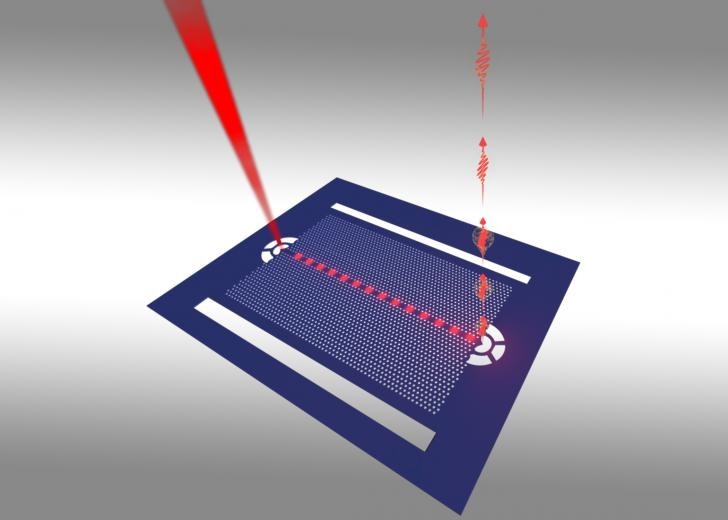Jul 10 2019
Scientists from the U.S. Naval Research Laboratory (NRL) have come up with a new method that could pave the way for future progress in quantum technology.
 Schematic of a nanoscale structure called a “photonic crystal waveguide” that contains quantum dots that can interact with one another when they are tuned to the same wavelength. (Image credit: Chul Soo Kim, U.S. Naval Research Laboratory)
Schematic of a nanoscale structure called a “photonic crystal waveguide” that contains quantum dots that can interact with one another when they are tuned to the same wavelength. (Image credit: Chul Soo Kim, U.S. Naval Research Laboratory)
The method involves squeezing quantum dots, which are tiny particles composed of thousands of atoms, to liberate single photons (individual light particles) with exactly the same color and with positions that could be spaced out by less than one-millionth of a meter.
“This breakthrough could accelerate the development of quantum information technologies and brain-inspired computing,” stated Allan Bracker, a chemist at NRL and one of the researchers on the project.
If quantum dots have to “communicate” (interact), they must emit light at the same wavelength. This emission wavelength is governed by the size of a quantum dot. Yet, quite similar to how no two snowflakes are identical, no two quantum dots have precisely the same shape and size—at least when they form initially.
This innate irregularity renders it improbable for scientists to make quantum dots that emit light at exactly the same wavelength (color), stated Joel Grim, NRL physicist and the lead researcher on the project.
Instead of making quantum dots perfectly identical to begin with, we change their wavelength afterwards by shrink-wrapping them with laser-crystallized hafnium oxide. The shrink wrap squeezes the quantum dots, which shifts their wavelength in a very controllable way.
Joel Grim, Physicist, U.S. Naval Research Laboratory
Although “tuning” of quantum dot wavelengths has already been demonstrated by other researchers in the past, this is the first time scientists have realized it exactly in both position and wavelength.
“This means that we can do it not just for two or three, but for many quantum dots in an integrated circuit, which could be used for optical, rather than electrical computing,” stated Bracker.
The extensive science assets and researcher expertise at NRL enabled the team to investigate different strategies to achieve this quantum dot advancement in a comparatively short period of time.
“NRL has in-house facilities for crystal growth, device fabrication, and quantum optical measurements,” stated Grim. “This means that we could immediately coordinate our efforts to focus on rapidly improving the material properties.”
Grim and Bracker said that this milestone of controlling quantum dots could be the basis for future endeavors in various fields.
NRL’s new method for tuning the wavelength of quantum dots could enable new technologies that use the strange properties of quantum physics for computing, communication and sensing. It may also lead to ‘neuromorphic’ or brain-inspired computing based on a network of tiny lasers.
Allan Bracker, Chemist, U.S. Naval Research Laboratory
According to the researchers, this innovative approach might even be beneficial for applications where space and power efficiency are limiting factors.
The study titled “Scalable in operando strain tuning in nanophotonic waveguides enabling three-quantum-dot superradiance” has been published in the Nature Materials journal.